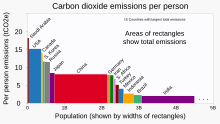Australian Greenhouse Gas Emissions by Source Sector (Sept. 2023)[1]

Greenhouse gas emissions by Australia totalled 533 million tonnes CO2-equivalent based on greenhouse gas national inventory report data for 2019; representing per capita CO2e emissions of 21 tons,[3] three times the global average. Coal was responsible for 30% of emissions. The national Greenhouse Gas Inventory estimates for the year to March 2021 were 494.2 million tonnes, which is 27.8 million tonnes, or 5.3%, lower than the previous year. It is 20.8% lower than in 2005 (the baseline year for the Paris Agreement). According to the government, the result reflects the decrease in transport emissions due to COVID-19 pandemic restrictions, reduced fugitive emissions, and reductions in emissions from electricity; however, there were increased greenhouse gas emissions from the land and agriculture sectors.[4]
Australia uses principally coal power for electricity, accounting for 66% of grid-connected electricity generation in 2020,[5] but this is rapidly decreasing with a growing share of renewables making up the energy supply mix, and most existing coal-fired power station scheduled to cease operation between 2022 and 2048.[6] Emissions by the country have started to fall and are expected to continue to fall in coming years as more renewable projects come online.[7]
Climate Action Tracker rates Australia's overall commitment to emissions reduction as "insufficient". Policies and action is "insufficient", domestic target is "almost sufficient", fair share target is "insufficient", and climate finance is "critically insufficient". This is because the Australian government has continued to invest in natural gas projects, refused to increase its 2030 domestic emissions target, and is not on track to meet its current target.[8]
Climate change in Australia is caused by greenhouse gas emissions, and the country is generally becoming hotter, and more prone to extreme heat, bushfires, droughts, floods and longer fire seasons because of climate change.[9]
- ^ "Australia: yearly greenhouse gas emissions by source 2023". Statista. Retrieved 27 April 2024.
- ^ ● Source for carbon emissions data: "Territorial (MtCO₂) / Emissions / Carbon emissions / Chart View". Global Carbon Atlas. 2024.
● Source for country population data: "Population 2022" (PDF). World Bank. 2024. Archived (PDF) from the original on 22 October 2024. - ^ "Australia. 2019 National Inventory Report (NIR)". United Nations Climate Change. Australia. 24 May 2019. Archived from the original on 16 August 2021. Retrieved 24 April 2021.
- ^ Department of Industry, Science (31 August 2021). "Australia's greenhouse gas emissions: March 2021 quarterly update". Department of Industry, Science, Energy and Resources. Archived from the original on 10 October 2021. Retrieved 9 October 2021.
- ^ Dylan McConnell; Simon Holmes à Court; Steven Tan; Nik Cubrilovic. "An Open Platform for National Electricity Market Data". OpenNEM. Archived from the original on 6 November 2021. Retrieved 24 April 2021.
- ^ "2020 Transmission Annual Planning Report" (PDF). TransGrid. June 2020. Archived (PDF) from the original on 14 August 2021. Retrieved 24 April 2021.
- ^ "Australia's emissions to start falling thanks to renewables boom, researchers say". The Guardian. 23 October 2019. Archived from the original on 13 August 2021. Retrieved 3 March 2020.
- ^ "Australia". climateactiontracker.org. Archived from the original on 19 November 2021. Retrieved 9 October 2021.
- ^ "Climate change in Australia". CSIRO. 24 December 2020. Archived from the original on 30 October 2021. Retrieved 24 April 2021.